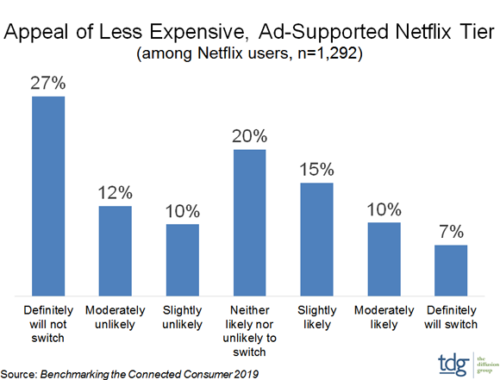Third of Netflix subscribers might switch to a cheaper, ad-supported tier
Tuesday, July 9th, 2019
TDG: A Third of Netflix Subscribers Would Consider Switching to a Less Expensive, Ad-Supported Tier
- 17% moderately likely to or definitely would switch
LOS ANGELES, CA — Recent comments from NBCU and Hulu executives have rekindled speculation as to whether Netflix will introduce an ad-based tier. Given the rising costs of programming and growing debt, so goes the argument, it is just a matter of time before the company makes a move.
But how many domestic Netflix users would switch to a less-expensive, ad-based tier?
According to new TDG research, a third of Netflix users would consider changing tiers, more than half of which are moderately likely to or definitely would switch.

While Netflix has consistently spurned ads, the decision is not entirely within its control, says Michael Greeson, President of TDG and Senior Vice President of Screen Engine/ASI. In the next year, many of Netflix’s most-viewed shows will disappear from its library, as networks like Disney and WarnerMedia reclaim their high-value titles in order to populate their own DTC services.
While top of mind among Netflix executives, awareness does not logically entail timely, correct action. “Netflix’s response to its thinning third-party library is to spend more on originals, which it’s gambling will keep subscribers from jumping ship. But with half or more of its most-viewed shows being owned by three studios, each of which is launching their own DTC services, how long can you convince 55+ million US consumers that your service is worth paying a premium price, especially compared with Hulu (offers an ad-based option), Amazon Prime Video (free with Prime), and Disney+ (coming in a $6.99/month)?”
Given this context, and in order to offset mounting costs and pressure from investors to begin paying down debt, Netflix will need to (1) increase the retail prices of subscriptions (which it recently did), or (2) create a new revenue stream, such as advertising.
“This should not be an either/or decision, but that’s what it is,” said Greeson. TDG’s research from late 2018 found that Netflix’s most recent price increase strained the limit of the service’s value, even before popular third-party shows are pulled from the lineup. When this happens, short-term domestic price increases will be difficult if not impossible without deleterious results.
As with Blockbuster in the 2000s, Netflix has long enjoyed dominance in its market space, producing a bit of over-confidence and an embedded resistance to change. Given shifting competitive conditions, however, flexibility is essential — something with which Netflix has limited experience. Like Blockbuster, it largely defined its space, set the rules, and long since reigned. “But the stage is shifting,” says Greeson, “and if, like Blockbuster, Netflix fails to evolve in a timely fashion, the company may see its domestic fortunes reversed.”
On the other hand, Netflix could bend a bit and launch a less expensive ad-subsidized tier, something that Greeson predicts will happen in the next 18 months. “Ads will become an important part of a comprehensive tiering strategy that helps bullet-proof Netflix for years to come.”
The appeal of a less-expensive ad-based Netflix tier is but one component of TDG’s ninth annual Benchmarking the Connected Consumer study, a comprehensive profile of the devices and services used in the US broadband home.
Latest News
- Plex has largest FAST line-up with 1,112 channels
- TV3 migrates from on-prem servers to AWS Cloud with Redge
- Virgin Media partners with PubMatic to scale FAST advertising
- Interactive TV news channel unveiled by ROXi and Sinclair
- Spideo and OTTera unveil personalisation collaboration at NAB Show 2024
- Amagi integrates Intertrust DRM for FAST services